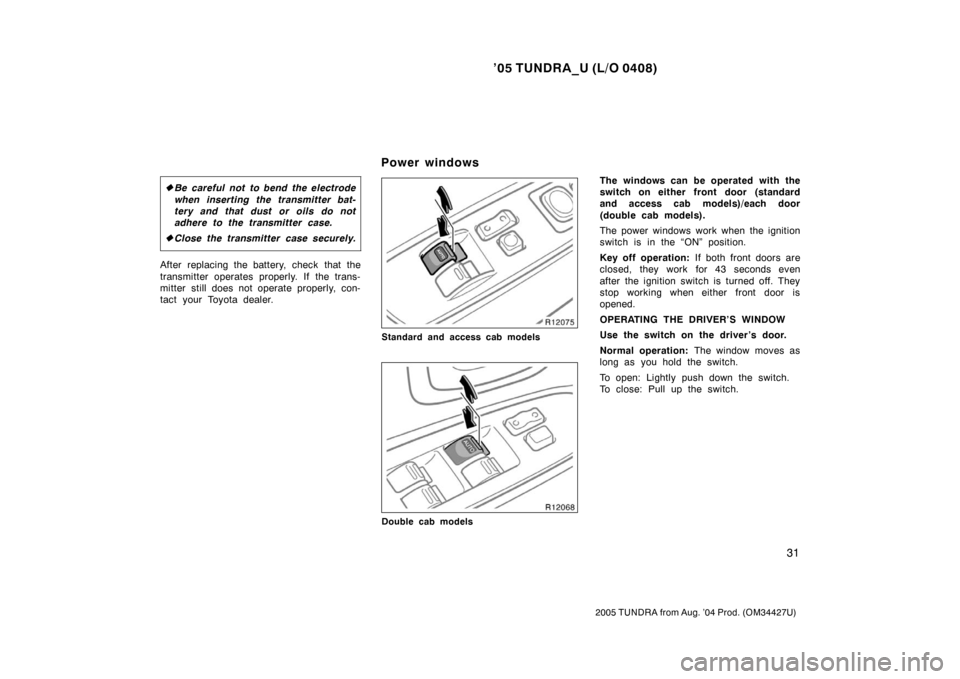Page 36 of 506
’05 TUNDRA_U (L/O 0408)
25
2005 TUNDRA from Aug. ’04 Prod. (OM34427U)
3. Remove the discharged transmitter bat-
tery.
NOTICE
Do not bend the terminals.
4. Put in a new transmitter battery withpositive (+) side up.
Place the rubber gasket back on the
transmitter. Then close the transmitter
case securely.
NOTICE
� Make sure the positive side and
negative side of the transmitter bat-
tery are faced correctly.
� Do not replace the battery with wet
hands. Water may cause unexpected
rust.
�Do not touch or move any compo-
nents inside the transmitter, or it
may interfere with proper operation.
� Be careful not to bend the electrode
when inserting the transmitter bat-
tery and that dust or oils do not
adhere to the transmitter case.
� Close the transmitter case securely.
After replacing the battery, check that the
transmitter operates properly. If the trans-
mitter still does not operate properly, con-
tact your Toyota dealer.
Page 42 of 506

’05 TUNDRA_U (L/O 0408)
31
2005 TUNDRA from Aug. ’04 Prod. (OM34427U)
�Be careful not to bend the electrode
when inserting the transmitter bat-
tery and that dust or oils do not
adhere to the transmitter case.
� Close the transmitter case securely.
After replacing the battery, check that the
transmitter operates properly. If the trans-
mitter still does not operate properly, con-
tact your Toyota dealer.
Standard and access cab models
Double cab models
The windows can be operated with the
switch on either front door (standard
and access cab models)/each door
(double cab models).
The power windows work when the ignition
switch is in the “ON” position.
Key off operation: If both front doors are
closed, they work for 43 seconds even
after the ignition switch is turned off. They
stop working when either front door is
opened.
OPERATING THE DRIVER’S WINDOW
Use the switch on the driver’s door.
Normal operation: The window moves as
long as you hold the switch.
To open: Lightly push down the switch.
To close: Pull up the switch.
Power windows
Page 178 of 506

’05 TUNDRA_U (L/O 0408)
167
2005 TUNDRA from Aug. ’04 Prod. (OM34427U)
The gauge indicates the engine coolant
temperature when the ignition switch is
on. The engine operating temperature
will vary with changes in weather and
engine load.
If the needle moves into the red zone,
your engine is too hot. If your vehicle
overheats, stop your vehicle and allow the
engine to cool.
Your vehicle may overheat during severe
operating conditions, such as:
�Driving up a long hill on a hot day.
�Reducing speed or stopping after high
speed driving.
�Idling for a long period with the air
conditioning on in stop −and− go traffic.
�Towing a trailer.
NOTICE
�Do not remove the thermostat in
the engine cooling system as this
may cause the engine to overheat.
The thermostat is designed to con-
trol the flow of coolant to keep the
temperature of the engine within
the specified operating range.
� Do not continue driving with an
overheated engine. See “If your ve-
hicle overheats” in Section 4.
Idling
Normal driving
The oil pressure gauge indicates engine
oil pressure when the ignition switch is
on. Check it while driving to make sure
that the needle is in the proper range.
If the oil pressure should stay below the
normal range, pull off the road to a safe
place and stop the engine immediately.
Call a Toyota dealer or qualified repair
shop for assistance.
Oil pressure may not build up when the
oil level is too low. The oil pressure
gauge is not designed to indicate oil level,
and the oil level must be checked using
the level dipstick.
Oil pressure gauge
Page 179 of 506

’05 TUNDRA_U (L/O 0408)
168
2005 TUNDRA from Aug. ’04 Prod. (OM34427U)
NOTICE
Do not drive the vehicle with the oil
pressure below the normal range until
the cause is fixed—it may ruin the
engine.
The voltmeter tells whether the battery
is charged or discharged. Check it
while the engine is running—the needle
should always indicate as shown above.
If the needle reads below or above the
normal range while the engine is running,
it indicates the charging system needs im-
mediate repair.
However, it is normal for the needle to
drop below the normal range during en-
gine starting.The tachometer indicates engine speed
in thousands of rpm (revolutions per
minute). Use it while driving to select
correct shift points and to prevent en-
gine lugging and over −revving.
Driving with the engine running too fast
causes excessive engine wear and poor
fuel economy. Remember, in most cases
the slower the engine speed, the greater
the fuel economy.
NOTICE
Do not let the indicator needle get
into the red zone. This may cause
severe engine damage.
Voltmeter Tachometer
Page 182 of 506
’05 TUNDRA_U (L/O 0408)
171
2005 TUNDRA from Aug. ’04 Prod. (OM34427U)
If the indicator or buzzer comes on...Do this.
(h)orTake vehicle to Toyota dealer.
(i)Take vehicle to Toyota dealer.
(j)Close all doors.
(k)Take vehicle to Toyota dealer immediately.
(l)Adjust tire inflation pressure (including spare tire). If the light blinks, contact Toyota
dealer.
(m)Stop and check.
(n)Add washer fluid.
(o)Replace engine oil.
Page 186 of 506

’05 TUNDRA_U (L/O 0408)
175
2005 TUNDRA from Aug. ’04 Prod. (OM34427U)
(e) Low Engine Oil Pressure Warning
Light
This light warns that the engine oil pres-
sure is too low.
If it flickers or stays on while you are
driving, pull off the road to a safe place
and stop the engine immediately. Call a
Toyota dealer or qualified repair shop for
assistance.
The light may occasionally flicker when
the engine is idling or it may come on
briefly after a hard stop. There is no
cause for concern if it then goes out when
the engine is accelerated slightly.
The light may come on when the oil level
is extremely low. It is not designed to
indicate low oil level, and the oil level
must be checked using the level dipstick.
NOTICE
Do not drive the vehicle with the
warning light on—even for one block.
It may ruin the engine.
(f) Malfunction Indicator Lamp
This lamp comes on when the ignition
key is turned to the “ON” position and
goes off after the engine starts. This
means that the warning light system is
operating properly.
If the lamp remains on, or the lamp
comes on while driving, first check the
followings.
�Empty fuel tank
If the fuel tank is empty, refuel immedi-
ately.
�Loose fuel tank cap
If the fuel tank cap is loose, securely
tighten it.
These cases are temporary malfunctions.
The malfunction indicator lamp will go off
after taking several driving trips.
If the lamp does not go off even after
several trips, contact your Toyota dealer
as soon as possible. If the fuel tank is not empty or the fuel
tank cap is not loose...
�There is a problem somewhere in the
engine, emission control system, elec-
tronic throttle control system, automatic
transmission electrical system or warn-
ing light system itself.
Contact your Toyota dealer as soon as
possible to service the vehicle.
If engine speed does not increase when
the accelerator pedal is depressed, there
may be a problem somewhere in the elec-
tronic throttle control system.
At this time, vibration may occur. Howev-
er, if you depress the accelerator pedal
more firmly and slowly, you can drive your
vehicle at low speeds. Have your vehicle
checked by your Toyota dealer as soon as
possible.
Even if the abnormality of the electronic
throttle control system is corrected during
low speed driving, the system may not be
recovered until the engine is stopped and
the ignition key is turned to “ACC” or
“LOCK” position.
Page 191 of 506

’05 TUNDRA_U (L/O 0408)
180
2005 TUNDRA from Aug. ’04 Prod. (OM34427U)
CHECKING SERVICE REMINDER
INDICATORS (except the low fuel level
warning light and low windshield
washer fluid level warning light)
1. Apply the parking brake.
2. Open one of the doors. The open door warning light should
come on.
3. Close the door. The open door warning light should go
off.
4. Turn the ignition key to “ON”, but do not start the engine.
All the service reminder indicators ex-
cept the open door warning light should
come on.
The following service reminder indica-
tors go off after a few seconds:
�“ABS” warning light
�“VSC TRAC” warning light
�Low tire pressure warning light
�Engine oil replacement reminder light
�Roll sensing of curtain shield airbag off
indicator light
�“AUTO LSD” indicator light
�“VSC OFF” indicator light
(four −wheel drive models)
�Slip indicator light
The SRS warning light goes off after
about 6 seconds.
There may be the case that the “ABS”
warning light (brake assist system
warning light), “VSC TRAC” warning
light, slip indicator light and “VSC OFF”
(four− wheel drive models) indicator light
stay on for about 60 seconds after the
ignition key is turned to the “ON” posi-
tion. It is normal if they go out after
a whi l e.
If any service reminder indicator or warn-
ing buzzer does not function as described
above, have it checked by your Toyota
dealer as soon as possible.
Page 252 of 506
’05 TUNDRA_U (L/O 0408)
241
2005 TUNDRA from Aug. ’04 Prod. (OM34427U)
Replace the battery by using the following
procedures:
1. Pull the case out while pushing the lock release button to the side.2. Remove the discharged battery.
3. Put in a new battery with the positive
(+) side up.
Put in the case securely.
NOTICE
�Make sure that the positive side of
the controller battery is facing cor-
rectly.
� Do not replace the battery with wet
hands. Water may cause rust.
� Do not touch or move any compo-
nents inside of the controller, or it
may interfere with proper operation.
�Be careful not to bend the electrode
of the controller battery insertion
and that dust or oil does not ad-
here to the transmitter case.
� Close the battery case securely.
After replacing the battery, check that the
controller operates properly. If the control-
ler still does not operate properly, contact
your Toyota dealer.